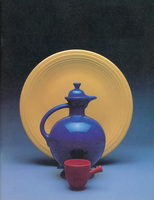 | Back to e-WV
| Back to e-WV
 The West Virginia Encyclopedia
The West Virginia Encyclopedia
 | Back to e-WV
| Back to e-WV
 The West Virginia Encyclopedia
The West Virginia Encyclopedia

West Virginia’s most famous collectible was introduced to the marketplace in 1936. The first Genuine Fiesta, a cheap, attractive dinnerware, included four colors and 54 individual items all designed in the streamlined Art Deco style. Produced in Newell, Hancock County, by the Homer Laughlin China Company, Fiesta was originally designed by one of the premier ceramics designers in the world, Frederick Hurten Rhead. As its popularity grew (during the 1940s, 2,500 workers produced 30 million pieces a year) new colors and serving items were introduced, as was Fiesta Kitchen Kraft, a food preparation, storage, and refrigerator-to-oven tableware.
History set the stage for Fiesta’s success. The Great Depression was over, as was World War I. The United States economy was starting to boom, the Homer Laughlin factory had modernized production, and company leaders were focusing on artistic development. For the first time in history, colored glazes were available.
Fiesta colors have included: red, yellow, cobalt blue, green, and old ivory (all 1936), turquoise (1937), forest green, rose, chartreuse, and grey (1951), medium green (1959), antique gold, turf green (avocado), and mango red, a reproduction of the original red (1969). Production ceased from 1973 until 1986 when white, pink (rose), black, cobalt blue, and apricot were introduced. Since then yellow, turquoise, periwinkle blue, sea mist green, lilac, persimmon, sapphire blue, chartreuse, pearl gray, juniper, cinnabar, sunflower, plum, shamrock, tangerine, scarlet, peacock, heather, evergreen, ivory, chocolate, lemongrass, paprika, marigold, flamingo, lapis, poppy, slate, sage, claret, daffodil, mulberry, meadow, butterscotch, twilight, peony, and jade have been produced. Colors are often retired after a few years, and new ones are regularly introduced.
Throughout its history, Fiesta has set standards for technology, tableware trends, and pop appeal. Andy Warhol collected it, major restaurant chains use it, television show and commercials feature it, and collector newsletters track it. Certain older pieces have sold for thousands of dollars. The current record is $12,075 for a Fiesta ivory red stripe covered onion soup bowl, which sold at auction in 2016.
In 2011, Fiestware was featured on a U.S. Postal Service stamp as part of a series that celebrated pioneers in American industrial design. The stamp featured two Fiesta pitchers designed by Frederick Hurten Rhead in 1936.
Written by Mack Miles
Huxford, Bob & Sharon Huxford. The Collector's Encyclopedia of Fiesta. Paducah, KY: Collector Books, 1992.